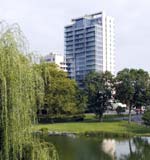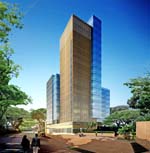
|
|
|
|
 |
|
Home Site Search Contact Us Subscribe
|
|
|
|
Q&A with Peter Morrison and J. Robert Hillier, FAIA, re: RMJM Hillier
By ArchNewsNow November 29, 2007 This past June, American and Scottish accents mixed and mingled at the Whitney Museum in New York City to announce the merger of Edinburgh-based RMJM and Princeton-based Hillier. Now combined, RMJM Hillier calls itself a “super-studio” with offices in 16 cities across North America, Europe, Asia, and the Middle East, with more than $15 billion in construction value of buildings currently under design.
ArchNewsNow (ANN) queried Peter Morrison, CEO, RMJM Ltd., and J. Robert Hillier, FAIA, Deputy Chairman, RMJM Group (holding company for RMJM Ltd.) about the why’s, wherefore’s, and future of the merger.
ANN: You’re 33 years old and running a 1,200 person architecture firm with 16 offices around the world. Intimidated?
Morrison: For me, it’s exciting not intimidating. We have some
of the most creative people in the industry, and with the addition of Hillier
to the mix we are able to deliver exciting projects to our clients throughout a
large part of the world. Of course there are challenges. Hillier is a business
of some 300+ professionals, and whenever you bring in a group of that size,
there are some rare challenges, but we see a lot of similarities and
opportunities that we’re ready to capitalize on. The key is to get everyone
talking.
Morrison: The strategy was to grow our business in key geographic markets that we weren’t already in, and the United States was a huge target from the start. A large part of the architecture profession is based there, and roughly 60% of architecture revenue comes out of the U.S. Also, many of our clients in Asia – hotel operators and developers – are based in the U.S. Another compelling reason to look to the U.S. is our higher education practice. It has been a core part of what we’ve done for 50 years, as it has for Hillier for nearly as long. The top American universities and colleges are expected to invest something along the lines of $40 billion in their campuses over the next 5 to 10 years. We think we have a lot to offer there. ANN: Why Hillier?
Morrison: We got the sense that it was a strong brand that had
been around for 40 years and that had a value attached to it. They also have a
similar culture. The way they think about design is the way we think about
design: buildings should be of their time and place. Both firms have a great
stable of designers and expertise in education that links well. All of that was
great, but it was really the relationships between people established over the
period leading up to the transaction that sealed the deal.
Hillier: I’m going to be doing what I’ve always been doing – chasing work. The only difference is I’m going to be chasing it all over the world. I’d personally like to be able to devote more time to seeking higher education projects – that’s really my passion, the roots of our firm, and we think we can take it to even better places with RMJM. I’ll still be the lead in local projects like the replacement hospital for the University Medical Center at Princeton and the West Windsor Redevelopment Plan. This new role just allows me to do what I love to do: be an architect, rather than manage the day to day operations of the firm. ANN: In the process of implementing a merger, how do you
integrate the management teams and the two cultures?
ANN: What do you see as the biggest challenge in bringing together two relatively large design firms?
Morrison: Definitely communication. In any firm of 1,200 people, communication is always going to be a big challenge, and we are working hard to ensure that people throughout our global network are communicating with one another regularly and effectively. This is so important in our business because there are people in each of our offices who have a specialist design skill or experience that could be useful on a project in another part of the world. We may have an expert in libraries in the Princeton office (we do, as a matter of fact) and we may have a requirement for that skill on a project in Moscow. We can only utilize this expertise if we’re aware of it, hence the importance of good communications.
We have brought together two firms with similar cultures who share a passion for design. This gives an exceptional range of design skills throughout our offices, from New York to Shanghai, and we must ensure we can bring the most creative solutions to bear whenever we are delivering a project, irrespective of where that project is or in which office the skills lie.
ANN: You’re background isn’t in architecture, yet you have immersed yourself in it at RMJM. What have you learned about architecture, and running an architecture firm that might not be obvious to an industry insider?
Morrison: My theory of managing a design firm is built around
one core principle – you have to ensure that your most creative people are
dedicating the majority of their time to designing. In other words, I
want to take the burden of operational and corporate administration off of the
designers as much as possible, and ensure they have the most efficient and
effective infrastructure and support systems around them so they spend all
their time providing the very best design services they can to our clients.
Morrison: Business school was a great experience and I learned a lot, but I think it was the army that taught me from a very young age how important it is to ensure that within a team you have people playing to their strengths at all times and that they have the most effective platform from which to excel at what they are good at. ANN: Moving forward, where do you think the emphasis will be for your business – the people, the technology, marketing?
Morrison: The emphasis will always be on ensuring we are providing our clients with the most creative and innovative design solutions. In order to do that we need to ensure we have the best people, operating in the most efficient, vibrant environment, all excited about working for the RMJM Group and all driven by design quality. We will continually strive to improve our business and that excites me.
Morrison: We’re very serious about the West Coast of the United States. We will have an office in San Francisco before the end of the year. We work on the basis that if we win an exciting project in a geographical area where we do not have an office, we will open one for the duration of the project and work on building a working knowledge of that market and a network that will allow us to create a sustainable business there.
|
(click on pictures to enlarge)  (RMJM Hillier) Okhta Center (a.k.a. Gazprom), St. Petersburg, Russia (RMJM Hillier) Beijing Olympic Conference Center, China (RMJM Hillier) 111 Central Park North, New York City (RMJM Hillier) LG R&D Center, Seoul, Korea (RMJM Hillier) Duke University-National University of Singapore Graduate Medical School |
© 2007 ArchNewsNow.com